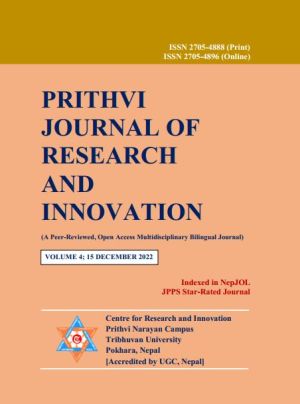कक्षा एघारका विद्यार्थीको नेपाली भाषा सिकाइप्रतिको अभिप्रेरणा [Grade 11 Students’ Motivation in Nepali Language Learning]
DOI:
https://doi.org/10.3126/pjri.v4i1.50164Keywords:
अभिप्रेरणा, अन्तरइच्छा, आवश्यकता, भाषा सिकाइ, मनोविज्ञान, Motivation, willingness, need, language learning, psychologyAbstract
प्रस्तुत लेख कक्षा ११ मा अध्ययनरत विद्यार्थीहरू नेपाली भाषाको औपचारिक सिकाइप्रति के कस्ता कारणले कसरी अभिप्रेरित हुन्छन् भन्ने उपायको खोजी गर्ने उद्देश्यले तयार पारिएको हो । प्रस्तुत लेख गुणात्मक अनुसन्धान ढाँचाको घटना क्रिया अध्ययनसँग सम्बन्धित रहेको छ । उद्देश्यमूलक नमुना छनोट विधिको उपयोग गरी छनोट गरिएका पोखरा महानगरपालिकाका कक्षा ११ मा अध्ययनरत सातजना विद्यार्थीसँग लिइएको अन्तर्वार्ताबाट प्राप्त तथ्यलाई व्याख्यात्मक विधिका माध्यमबाट अर्थपूर्ण विश्लेषण गरिएको छ । प्रस्तुत अध्ययनको मूल प्राप्तिलाई दृष्टिगत गर्दा नेपाली भाषा सिकाइप्रतिको अभिप्रेरणाका मुख्य पक्ष वा कारणहरूमा भाषिक स्वरूप र संरचना, सिकारुको रुचि र लक्ष्य, शिक्षकको व्यक्तित्व, क्षमता र व्यवहार, शिक्षण प्रक्रिया, पाठ्यक्रम तथा पाठ्यपुस्तक, विद्यालयको भौतिक पूर्वाधार र कक्षाकोठा व्यवस्थापन, मूल्याङ्कन परिपाटी, अन्य भाषाको प्रभाव, शिक्षाको माध्यम, देशको परिस्थिति मुख्य रहेका छन् । यी कारणअन्तर्गत रहेर सूचकहरूले केही समान तथा भिन्न अनुभवहरू अभिव्यक्त गरेका छन् । कुनै कामप्रतिको लगाव वा इच्छाशक्ति वैयक्तिक भिन्नतामा निर्भर गर्दछ । मानवीय आवश्यकता नै अभिप्रेरणाको मुख्य कारण हो । भाषिक स्वरूप र संरचना लगायतका माथि उल्लेखित तŒव वा पक्ष विद्यार्थीअनुकूल हुँदा नेपाली भाषा सिकाइ अभिप्रेरणामा सकारात्मक प्रभाव पार्ने र विद्यार्थीअनुकूल नहुँदा नकारात्मक प्रभाव पार्ने कुरा अध्ययनबाट प्राप्त भएको छ । वास्तवमा भाषा सिकाइ अभिप्रेरणाको सम्बन्ध सिकारुको मनोवैज्ञानिक पक्षसँग सम्बन्धित छ । सिकारु भित्रैदेखि खुसी भएर भाषा सिकाइमा लागेको छ भने उसले सफलता प्राप्त गर्न सक्छ । शिक्षण प्रक्रियामा संलग्न विविध वातावरणीय पक्षहरूले पनि भाषा सिकाइ अभिप्रेरणा जागृत गराइदिने काम गर्दछन् । तसर्थ नेपाली भाषा शिक्षकले सिकाइका बाह्य वातावरणीय पक्षहरूलाई सिकारुअनुकूल बनाई कक्षा ११ मा अध्ययनरत विद्यार्थीलाई नेपाली भाषाको औपचारिक सिकाइमा अभिप्रेरित गराउन सकिन्छ भन्ने निष्कर्ष यस लेखमा निकालिएको छ ।
[The paper aims to find out the reasons for the current Grade 11 students’ motivation in the Nepali language learning. The study has adopted the qualitative research method, using the phenomenological approach. The study has analyzed the data collected through interviews from seven Grade 11 students of different secondary schools in Pokhara Metropolitan City, using the purposive sampling technique for data collection. The findings of the study indicated that the major motivating factors of learning the Nepali language include the nature and structure of language, learners’ interest and objective, teachers’ personality, evaluation and behavior, teaching method, curriculum and textbooks, school infrastructure and classroom management, evaluation scheme, influences of other languages, medium of instruction, and the context of a nation. These factors have been expressed through both common and differing experiences, which are considered indicators. A person’s willingness towards his or her work depends on his or her personal likes and dislikes. In fact, human needs motivate a person to act in a way that gets him or her closer to his or her goals. The findings of the study showed that when the above mentioned structure and construction of language are student-centred, there was a positive impact on the Nepali language learning motivation and when it was not student-centred, it was found to have a negative impact on the Nepali language learning motivation. It was also found that the language learning motivation is associated with the psychology of the learners. For instance, if someone is eager to learn the language, he or she can learn the language successfully. In addition, there are also various aspects such as learning environment that can motivate the students in their language learning process. Thus, the study concludes that if we could create a learner-centred environment in schools, a Nepali language teacher can motivate the Grade 11 students to learn the Nepali language successfully.]
Downloads
Downloads
Published
How to Cite
Issue
Section
License
Copyright (c) 2022 Centre for Research and Innovation (CRI), Prithvi Narayan Campus (TU)

This work is licensed under a Creative Commons Attribution-NonCommercial 4.0 International License.
© Centre for Research and Innovation (CRI), Prithvi Narayan Campus (TU)

